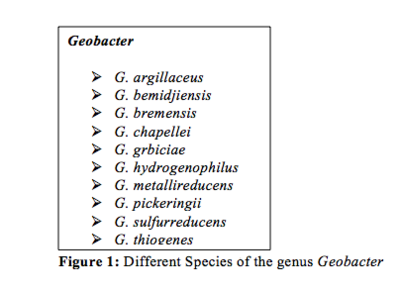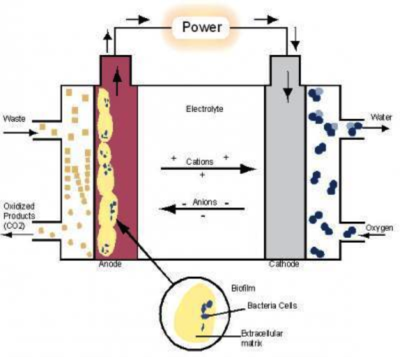The role of Geobacter spp. in Bioremediation and Microbial Fuel Cells
Introduction
Kingdom: Bacteria
Phylum: Proteobacteria
Class: Deltaproteobacteria
Order: Desulfuromonadales
Family: Geobacteraceae
Genus: Geobacter
All isolated Geobacter sp. are rod shaped and gram-negative. These species are all capable of acetate oxidation by reducing Fe (III). Moreover, the different species of Geobacter are capable of making electrical contacts with other organisms and electron acceptors outside the cell. The most intensively studied species of Geobacter are the G. metallireducens and the G. sulfurreducens. This ability accompanied by anaerobic respiration allows Geobacter to play an important role in a variety of anaerobic sedimentary environments. These environments include subsurface environments, aquatic sediments, rice paddies and wetlands where Fe (III) reduction as the terminal electron acceptor is extremely important [4]. Due to these characteristics Geobacter species have major applications in the fields of bioremediation and microbial fuel cells.
Bioremediation
Geobacter are capable of coupling the reduction of certain metal oxide such as Fe (III) and Mn (IV) to the oxidation of organic compounds in soils and many types of sediment. Some species are also able to oxidize aromatic hydrocarbons anaerobically and play a significant role in their removal from aquifers. These contaminations can be petroleum or landfill leachate [4].
Respectively, Geobacter metallireducens was found to be the first Geobacter that could degrade aromatic compounds [4]. More specifically it is able to anaerobically degrade benzene [10]. This is significant as it is the only organism that degrades benzene in an anaerobic pathway in pure culture [4].
Uranium is another metal contaminants that has been under great focus. The removal of uranium from ground water that is below drinking standards has been the prime focus in recent years. This is due to the low solubility of U (IV) and the rapid reduction of U (IV) by certain bacteria [9]. With regard to Geobacter, the extracellular reduction of uranium by conductive Geobacter pili is one such focus. Findings suggest that Geobacter pili have an essential function as protective and catalytic cellular mechanisms for bioremediation of ground water contaminated by uranium [2]. The ability of this genus to precipitate uranium reductively along with related contaminants has influenced the development of various bioremediation strategies [4]. In situ field evidence has been provided in support of the effectiveness of subsurface Geobacter species in the removal of uranium in contaminated groundwater. The results in this field study demonstrate that bioremediation of uranium from contaminated groundwater by Geobacter is feasible [1].
Microbial Fuel Cells
To understand the role of Geobacter in fuel cells it is important to comprehend what a microbial fuel cell is. The conventional microbial fuel cell consists of a cation or proton exchange chamber along with a cathode and anode linked in an electrical circuit [6].
The present microbial fuel cells produce outputs that are too low for most perceived practical applications. However there is a great opportunity to significantly increase this output by focusing on the strain and design used in the microbial fuel cell [5].
Geobacter produce current densities in microbial fuel cells that are higher than any known organism. They harvest electricity from aquatic sediments and organic waste by colonizing the electrodes [4].
Geobacter species can be used in short-term applications in microbial fuel cells in remote location such as the bottom of the ocean for powering electrical devices [8]. Their high efficiency in electron transfer is attributed to the pili along the length of their body that work as “microbial nanowires”. This property along with the ability of biofilms to work as super capacitors can contribute to bioelectronics [4].
More specifically, G. sulfurreducens form multilayer biofilms in microbial fuel cells at the anode surface. These are highly structured to convert acetate to electricity. The pili of G. sulfurreducens stimulate an increase in the number of cells stacking at the anode with a consequent increase in the production of current [7].
References
(1) Anderson, R. T., et al. 2003. Stimulating the in situ activity of Geobacter species to remove uranium from groundwater of a uranium-contaminated aquifer. Appl. Environ. Microbiol. 69: 5884-5891
(2) Cologgi, D. L., et al. 2011. Extracellular reduction of uranium via Geobacter conductive pili as a protective cellular mechanism. Proc. Natl. Acad. Sci. U. S. A. 108: 15248–15252
(3) Lovley, D.R., et al. 1993. Geobacter metallireducens gen. nov. sp. nov., a microorganism capable of coupling the complete oxidation of organic compounds to the reduction of iron and other metals. Arch Microbiol 159: 336–344.
(4) Lovley, D. R., et al. 2011. Geobacter: The Microbe Electric’s Physiology, Ecology, and Practical Applications. Advances in Microbial Physiology. 59: 1-100 DOI: 10.1016/B978-0-12-387661-4.00004-5
(5) Maylankar, N. K., et al. 2012. Biofilm conductivity is a decisive variable for high-current-density Geobacter sulfurreducens microbial fuel cells. Energy Environ. Sci. 5: 5790-5797.
(6) Poddar, S., and Khurana, S. 2011. Geobacter: The Electric Microbe! Efficient Microbial Fuel Cells to Generate Clean Cheap Electricity. Indian J Microbiol. 51(2): 240-241. DOI: 10.1007/S12088-011-0180-8
(7) Reguera, G., et al. 2006. Biofilm and nanowire production leads to increased current in Geobacter sulfurreducens fuel cells. Appl. Environ. Microbiol. 72: 7345-7348.
(8) Tender, L.M., et al. 2008. The first demonstration of a microbial fuel cell as a viable power supply: powering a meterological buoy. J. Power Sourc. 179, 571–575.
(9) Williams, K.H., et al. 2011. Acetate Aavailability and its influence on sustainable bioremediation of uranium-contaminated groundwater. Geomicrobiol. J. 28, 519–539.
(10) Zhang, T., et al. 2011. Anaerobic benzene degradation by Geobacter species with Fe(III) or an electrode as the electron acceptor. In: The 111th General Meeting of the American Society of Microbiology, New Orleans, LA.


